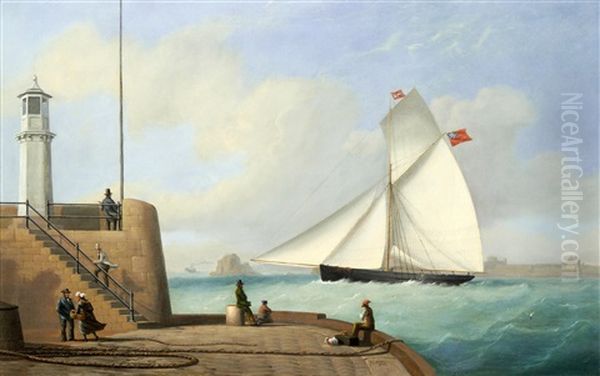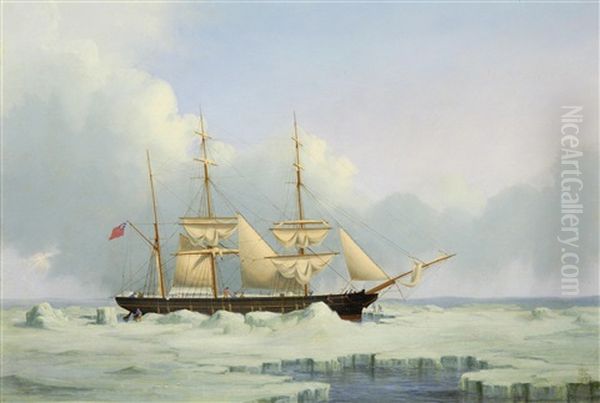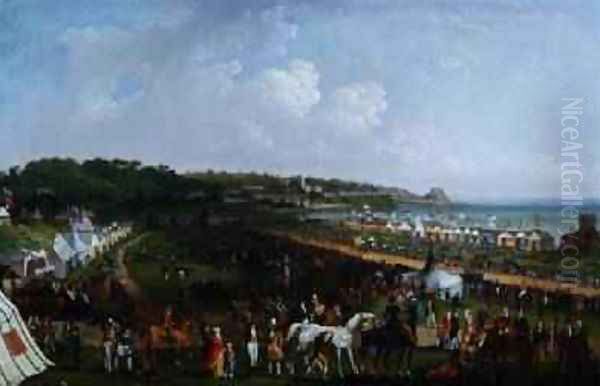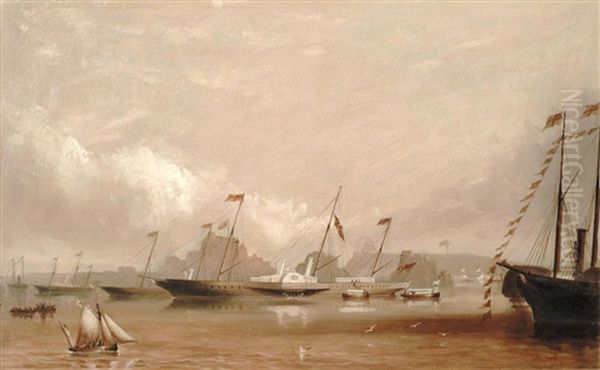Philip John Ouless stands as a pivotal figure in the artistic heritage of Jersey, a Channel Island with a rich maritime history. Active during the vibrant 19th century, Ouless was not merely a painter but a visual historian, capturing the essence of his island home, its seafaring prowess, and its significant moments with remarkable skill and dedication. His legacy extends beyond his canvases, encompassing his pioneering work in photography and his role in a distinguished artistic family.
Early Life and Artistic Formation
Born in St Helier, Jersey, in 1817, Philip John Ouless, often referred to simply as Philip Ouless, was the son of Philippe Ouless, an auctioneer. His familial roots traced back to Coutances in Normandy, France, from where his grandparents had fled to Jersey. This French connection perhaps played a role in his later decision to pursue artistic training in Paris. The French capital, a crucible of artistic innovation and academic tradition, would have provided young Ouless with exposure to a wide range of styles and techniques, particularly the burgeoning Romantic movement and the established conventions of marine and landscape painting.
Upon completing his studies in Paris, Ouless returned to Jersey, equipped with the skills to embark on a career as a painter. He quickly established himself, specializing in marine subjects, landscapes, and portraiture. His timing was fortuitous, as Jersey was experiencing a significant boom in its shipbuilding industry during the mid-19th century. This maritime prosperity created a demand for artists who could immortalize the island's vessels and the men who sailed them.
The Foremost Marine Painter of Jersey
The 19th century was a golden age for marine painting, with artists across Europe capturing the drama and beauty of the sea. In Britain, figures like J.M.W. Turner had already revolutionized the genre with his atmospheric and often turbulent depictions, while Clarkson Stanfield was renowned for his accurate and detailed maritime scenes. Ouless, working in Jersey, carved his own niche, becoming one of the island's most celebrated marine artists.

His reputation grew as he received numerous commissions from shipowners and captains eager to have their vessels meticulously recorded. These were not just artistic endeavors but also proud statements of commercial success and maritime skill. Ouless's paintings of ships were characterized by their accuracy and attention to detail, reflecting a deep understanding of naval architecture and the nuances of sailing. Works such as The Cutter Eclipse and A Jersey barque caught in the ice exemplify his ability to capture both the elegance of a vessel and the perils of the sea. His painting HMS Victory at anchor in Portsmouth Harbour demonstrates his skill in depicting iconic naval ships with precision.
Ouless was considered part of a notable trio of "Jersey Artists" of the 19th century, alongside Jean Le Capelain (1812-1848) and John Everett Millais (1829-1896). While Millais would go on to become a leading figure of the Pre-Raphaelite Brotherhood in London, alongside artists like Dante Gabriel Rossetti and William Holman Hunt, Ouless and Le Capelain remained more closely associated with the artistic documentation of Jersey itself.
Chronicler of Royal Visits and Island Life
A significant event in Ouless's career, and in the history of Jersey, was the visit of Queen Victoria and Prince Albert in 1846. This was a momentous occasion, marking the first official visit by a reigning British monarch to the island. At a time when photography was still in its infancy and not yet widely adopted for such extensive documentation, the role of artists was paramount. Philip Ouless, along with Jean Le Capelain, was tasked with creating a pictorial record of this historic event.
Ouless produced a series of eleven watercolors depicting various scenes from the royal visit, including the Queen's arrival and departure. These works, such as Queen Victoria's Departure, were not only artistically accomplished but also served as important historical documents. They were subsequently published in 1847, making the images accessible to a wider audience and preserving the memory of the occasion for posterity. His series Scenic Beauties of Jersey was also notably gifted to Queen Victoria, further cementing his status.
Beyond grand events, Ouless also captured the everyday life and significant local happenings of Jersey. His painting Grouville Common (1849) records the island's largest annual fair, offering a vibrant glimpse into the social fabric of the community. He also documented more dramatic events, such as shipwrecks, with some of these works being published in the Illustrated London News, a popular periodical that brought visual news to a national audience, much like the work of other illustrators of the time who contributed to such publications.
A Pioneer in Photography

Philip Ouless's artistic endeavors were not confined to the brush and canvas. He was also an early adopter and pioneer of photography in Jersey. In 1845, during a trip to France, he learned the Daguerreotype process. This early photographic technique, invented by Louis Daguerre and publicly announced in 1839, produced a highly detailed, unique image on a silvered copper plate.
Ouless is credited with introducing the Daguerreotype to Jersey. He even attempted to establish a portrait photography studio, though this venture was reportedly not sustained for long, with painting remaining his primary focus in St. Helier. Nevertheless, his involvement with photography at such an early stage is significant. He is believed to have taken photographs during Queen Victoria's 1846 visit, which, if they survive, would be among the earliest photographic records of the island and the royal event. This dual practice of painting and photography was not uncommon among artists seeking to explore new modes of representation, such as David Octavius Hill and Robert Adamson in Scotland, who famously collaborated on calotype portraits.
His interest in photography also extended to his family. His grandson, Clarence Ouless (1862-1942), would later also work as a photographer, continuing a family tradition in visual arts.
Travels and Broadening Horizons
Like many artists of his era, Ouless understood the value of travel for inspiration and artistic development. His journey to Paris for formal training was just the beginning. In 1845, he undertook a significant European tour, which included a journey along the Rhine River. This trip resulted in a series of large watercolors depicting the landscapes and notable sites along the river, showcasing his skill in capturing scenic beauty beyond his native island.
He also made trips to Rouen, Brittany, and various parts of Britain. These excursions would have exposed him to different landscapes, artistic communities, and perhaps the work of other contemporary artists. For instance, the coastal scenes of Brittany were a popular subject for many French painters, including Eugène Boudin, who was a mentor to Claude Monet and a master of capturing coastal light and atmosphere. While Ouless's style remained largely detailed and representational, such travels undoubtedly enriched his visual vocabulary.
Artistic Style and Notable Works
Philip Ouless's artistic style is primarily characterized by its meticulous detail, accuracy, and a strong narrative quality, particularly in his marine paintings and historical scenes. He worked proficiently in both oils and watercolors.

His marine paintings, often commissioned, required a high degree of precision in depicting the rigging, hull, and sails of specific vessels. Works like Courier (1853), showing the steam packet arriving in St. Helier, or The Cutter Eclipse, are fine examples of ship portraiture, valued for their fidelity as much as their artistry. He could also convey the power and mood of the sea, as seen in A Jersey barque caught in the ice, which hints at the dangers inherent in seafaring.
In his landscapes and historical depictions, such as the scenes from Queen Victoria's visit or Grouville Common, Ouless demonstrated a keen eye for composition and the ability to manage complex scenes with multiple figures and activities. His watercolor Icho Tower showcases his skill in rendering local landmarks with clarity and a sense of place. An earlier work, Graham's Island after the Volcanic Eruption (1831), indicates an interest in dramatic natural phenomena, a theme popular with Romantic artists like John Martin or Francis Danby, though Ouless's treatment would likely have been more topographically focused.
His approach was generally aligned with the Victorian taste for realism and narrative clarity, rather than the more experimental or impressionistic styles that began to emerge later in the century with artists like James Abbott McNeill Whistler or the French Impressionists.
Legacy and Collections
The significance of Philip John Ouless to Jersey's cultural heritage is substantial. His body of work provides an invaluable visual record of the island's maritime life, social customs, and historical events during a transformative period in the 19th century.
A significant collection of his works, including watercolors, sketchbooks, and personal items such as his passport and letters, is preserved by the Société Jersiaise. This institution plays a crucial role in safeguarding and promoting Jersey's history and culture, and its Ouless collection is a testament to his importance. These artifacts offer insights not only into his finished artworks but also into his working methods, travels, and personal life.
His paintings are held in various public and private collections, and they continue to be appreciated for their artistic merit and historical value. They serve as a window into a bygone era, allowing contemporary audiences to connect with Jersey's past.
An Artistic Family

The artistic talent in the Ouless family did not end with Philip. His son, Walter William Ouless (1848-1933), became an even more widely recognized artist, though in a different field. Walter established himself as a prominent portrait painter in London. He achieved considerable success, exhibiting regularly at the Royal Academy of Arts and eventually being elected a full Royal Academician (RA) in 1881. To be an RA was a significant honor, placing him in the company of leading British artists of the day, such as Frederic Leighton, John Everett Millais (Philip's fellow "Jersey Artist" who had achieved great fame), Lawrence Alma-Tadema, and George Frederic Watts.
Walter William Ouless's success as a portraitist in the competitive London art world underscores the artistic environment in which he was raised. Philip Ouless's dedication to his craft and his own achievements undoubtedly provided a strong foundation and inspiration for his son. As mentioned, the artistic lineage continued with Philip's grandson, Clarence Ouless, who pursued photography.
Contemporaries and the Wider Artistic Context
To fully appreciate Philip Ouless's contribution, it's helpful to consider him within the broader artistic context of his time. In Britain, the Victorian era saw a flourishing of the arts, with diverse styles and subjects. Marine painting was particularly popular, given Britain's naval power and maritime trade. Artists like Clarkson Stanfield and E.W. Cooke were highly regarded for their detailed and dramatic sea pieces. J.M.W. Turner, though an earlier figure, continued to influence with his visionary approach to light and atmosphere.
In France, where Ouless studied, marine painting also had a strong tradition, with artists like Théodore Gudin and Eugène Isabey producing notable works. The Barbizon School, with painters such as Jean-Baptiste-Camille Corot and Théodore Rousseau, was shifting landscape painting towards greater naturalism, which may have influenced Ouless's approach to landscape.
The rise of illustrated journalism, exemplified by the Illustrated London News, created new opportunities for artists to disseminate their work and document current events, a sphere in which Ouless participated. This period also saw the ascendancy of the Royal Academy in London as the premier art institution, setting tastes and standards, an institution his son Walter would later join. Other prominent Victorian artists whose careers overlapped with Ouless include Sir Edwin Landseer, famed for his animal paintings, and William Powell Frith, known for his sprawling narrative scenes of modern life like Derby Day.
While Ouless may not have achieved the international fame of some of these figures, his importance to Jersey and his specific contributions as a marine painter and historical chronicler are undeniable. He operated within a specific regional context but was clearly aware of and participated in broader artistic and technological developments, such as the advent of photography.
Conclusion: A Lasting Imprint on Jersey's Art
Philip John Ouless (1817-1885) was more than just a skilled painter; he was a visual custodian of Jersey's identity in the 19th century. Through his meticulous marine paintings, he celebrated the island's shipbuilding prowess and seafaring spirit. His depictions of significant events, most notably the 1846 royal visit, have become invaluable historical records. Furthermore, his early adoption of photography marks him as a forward-thinking individual, keen to explore new mediums of visual representation.
His dedication to his art, his ability to capture the essence of his subjects, whether a stately ship, a bustling local fair, or a royal procession, ensured his place as one of Jersey's most important 19th-century artists. The legacy of his work, carefully preserved and still admired today, continues to tell the story of Jersey and its people. Coupled with the artistic achievements of his son, Walter William Ouless, the Ouless name holds a distinguished place in the annals of British and Channel Islands art history. Philip John Ouless remains a testament to the power of art to define and preserve the character of a place and its time.